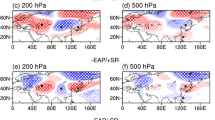Abstract
In this study, the interdecadal changes in the zonal symmetry of both Arctic Oscillation (AO) and Antarctic Oscillation (AAO) were analyzed. To describe the zonal asymmetry, a local index of AO and AAO was defined using the normalized sea level pressure (SLP) differences between 40° and 65° (latitudes) in both hemispheres. The zonal covariability of local AO and AAO can well represent the zonal symmetry of AO and AAO. Results show that the zonal asymmetry of both AO and AAO significantly changed in the late 1970s. AO was less asymmetric in the zonal direction in the boreal winter season during the latter period, while in the boreal summer it became more asymmetric after 1979. The zonal symmetry of AAO in both austral summer and winter has also significantly decreased since the late 1970s. These changes may imply interdecadal transition in the atmospheric circulation at middle and high latitudes, which is of vital importance to understanding climate variability and predictability across the globe, including the African-Asian-Australian monsoon regions.
Similar content being viewed by others
References
Fan, K., 2007: Zonal asymmetry of the Antarctic Oscillation. Geophys. Res. Lett., 34, doi: 10.1029/2006GL028045.
Fan, K., and H. J. Wang, 2004: Antarctic oscillation and the dust weather frequency in North. Geophys. Res. Lett., 31, doi: 10.1029/2004GL019465.
Gao, H., F. Xue, and H. J. Wang, 2003: Influence of interannual variability of Antarctic Oscillation on Mei-Yu along the Yangtze and Huaihe River valley and its importance to prediction. Chinese Science Bulletin, 48(Suppl.II), 61–67.
Gong, D. Y., and S. W. Wang, 1998: The Antarctic Oscillation: concept and apllications. Chinese Science Bulletin, 43(9), 734–738.
Gong, D. Y., and S.W. Wang, 1999: Definition of Antarctic Oscillation index. Geophys. Res. Lett., 26(4), 459–462.
Hu, Q., and S. Feng, 2010: Influence of the Arctic Oscillation on central United States summer rainfall. J. Geophys. Res., 115, doi: 10.1029/2009JD011805.
Ju, J., J. Ren, and J. Lv, 2004: Effect of interdecadal variation of Arctic Oscillation on temperature increasing in North of East Asian winter. Plateau Meteorology, 23(4), 429–434. (in Chinese)
Ju, J., J. Lv, and J. Ren, 2006: The effect of interdecadal variations of Arctic Oscillation on aridzation in North China. Plateau Meteorology, 25(1), 74–81. (in Chinese)
Kalnay, E., and Coauthors, 1996: The NCEP/NCAR 40-year reanalysis project. Bull. Amer. Meteor. Soc., 77, 437–471.
Lim, Y. K., and S. D. Schubert, 2011: The impact of ENSO and the Arctic Oscillation on winter temperature extremes in the southeast United States. Geophys. Res. Lett., 38, doi: 10.1029/2011GL048283.
Rigor, I. G., R. L. Colony, and S. Martin, 2000: Variations in surface air temperature observations in the Arctic, 1979–97. J. Climate, 13(5), 896–914.
Sun, J., H. J. Wang, and W. Yuan, 2009: A possible mechanism for the co-variability of the boreal spring Antarctic Oscillation and the Yangtze River valley summer rainfall. International Jouranl of Climatology, 29(9), 1276–1284.
Sun, J., H. J. Wang, and W. Yuan, 2010: Linkage of the boreal spring Antarctic Oscillation to the West African summer monsoon. J. Meteor. Soc. Japan., 88(1), 15–28.
Thompson, D.W. J., and J. M. Wallace, 1998: The Arctic Oscillation signature in the wintertime geopotential height and temperature fields. Geophys. Res. Lett., 25(9), 1297–1300.
Thompson, D. W. J., J. M. Wallace, and G. C. Hegerl, 2000: Annular modes in the extratropical circulation. Part II: Trends. J. Climate, 13(5), 1018–1036.
Wang, H. J., and K. Fan, 2007: Relationship between the Antarctic Oscillation in the Western North Pacific typhoon frequency. Chinese Science Bulletin, 52(4), 561–565.
Wang, H. J., J. Sun, and J. Su, 2008: The Arctic Oscillation is more zonal symmetric than the Antarctic Oscillation. Chinese Science Bulletin, 53(2), 247–250. (in Chinese)
Wu, Q., and X. Zhang, 2011: Observed evidence of an impact of the Antarctic sea ice dipole on the Antarctic Oscillation. J. Climate, 24, 4508–4518.
Zhou, B., P. Zhao, Z. Jian, and J. He, 2005: Modeling the impact of Australian Plate drift on Southern Hemisphere climate and environment. Chinese Science Bulletin, 50(14), 1495–1502.
Author information
Authors and Affiliations
Corresponding author
Rights and permissions
About this article
Cite this article
Liu, S., Wang, H. Transition of zonal asymmetry of the Arctic Oscillation and the Antarctic Oscillation at the end of 1970s. Adv. Atmos. Sci. 30, 41–47 (2013). https://doi.org/10.1007/s00376-012-2027-6
Received:
Revised:
Published:
Issue Date:
DOI: https://doi.org/10.1007/s00376-012-2027-6




